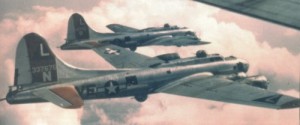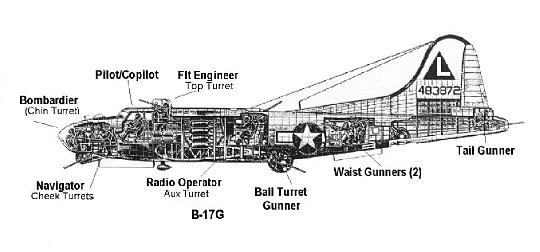The B-17 "Flying Fortress"
By Martin Kelley Presswood
The B-17 "Flying Fortress" was designed, developed, and built by the Boeing Aircraft Corporation of Seattle, Washington in the late 1930s and early 1940s for the U.S. Army to be used in strategic heavy bombardment combat missions against enemy military targets during WWII. Some were built by Douglas Aircraft and some by Lockheed-Vega. The B-17 went through eight model changes from the B-17A through the B-17G to increase the payload, increase the speed, add more guns, and increase the altitude at which it could fly. The last change was to add the chin turret with two additional guns to the B-17G to improve fighter protection.
|
The B-17G model was powered by four Wright- Cyclone 1820 cubic inch 9-cylinder radial air-cooled 1200 hp engines, each engine being equipped with a turbo-supercharger for high altitude flying. It had a wingspan of 103 feet 9 inches, a length of 74 feet 9 inches, and a height of 19 feet 1 inch at its vertical tail fin. Fully loaded it weighed about 65,000 pounds and had a maximum speed of 263 mph at 25,000 feet (300 mph at 30,000 feet), but could climb to a maximum altitude of 35,000 feet. On a typical combat mission it carried a bomb load of 4000 pounds to 6000 pounds, was loaded with 2800 gallons of 100-octane gasoline, and had a range of about 1850 miles. The engines delivered power to three-bladed constant speed propellers. Engines turned at 1800 rpm at a typical cruising speed of 160 mph. Take off speed was about 110 mph with engines turning at 2500 rpm, and landing speed was about 80 mph.
The B-17G was equipped with twelve 50-caliber machine guns: two chin turret guns under the nose; two cheek guns, one on each side of the nose; two top turret guns behind the cockpit; two ball turret guns under the |
B-17G Flying Fortress
Type:
Four-Engined Heavy Bomber |
Crew:
10
Wingspan:
103ft 9in
Length:
74ft 9in
Height:
19ft 1in
(at vertical fin) |
Maximum Speed:
263mph @ 25,000ft
Combat Payload:
4000-6000lbs
Combat Range:
1,850mi
Defensive Armament:
(12) .50-caliber MGs |
|
 |
For an added protection against enemy fighters, combat missions were flown with the B-17's flying in close formation. In close formation flying, a crew of nine operated the B-17: a pilot, a co-pilot, a navigator, a bombardier, a radio operator, a flight engineer/top turret |
gunner, a ball turret gunner, a waist gunner, and a tail gunner. In training and on some combat missions, a second waist gunner was added making a crew of ten.
Bombs were dropped at altitudes ranging from 20,000 feet to 30,000 feet. The inside of the B-17 was not pressurized, so it was necessary for each crew member to wear an oxygen mask at altitudes above 10,000 feet. Some heat was delivered to the inside of the airplane from the exhaust heat of the engines, but the crew members wore electrically heated clothing to protect themselves from high altitude temperatures often as much as 50 degrees below zero.
Each B-17 was equipped with an autopilot and a Norden bombsight. The two were interconnected in such a manner so that on a bomb run the bombsight took over the flying of the airplane to assure that a constant airspeed, a constant altitude, and a proper heading were maintained. This enabled the bombardier to program the information into the bombsight, and once it was aimed at the target the sight would stay fixed on the target as the B-17 moved toward the target. At the proper time based on the altitude and the speed of the airplane, the bombsight would automatically trigger the release of the bombs. On a clear day when the enemy target was plainly visible, this amazing bombsight made it possible to bomb military targets of the enemy with pinpoint accuracy from altitudes as high as 30,000 feet.
Many stories have been written about the endurance of the B-17 airplane and the punishment it could take and still fly. Even though it was not invincible, it was a remarkable airplane. Veterans of the 390th Bomb Group are helping to preserve the role the B-17 airplane played in military history by having one on display in the 390th Memorial Museum located on the grounds of the Pima Air & Space Museum near Tucson, Arizona. |



